Hydrological Modelling and Multisite Calibration of the Okavango River Basin: Addressing Catchment Heterogeneity and Climate Variability
Abstract
1. Introduction
2. Data and Methods
2.1. Study Area Description
2.2. Model Input and Data Source
2.2.1. Digital Elevation Model (DEM)
2.2.2. Land Use Land Cover (LULC)
2.2.3. Soil Map of the Study Area
2.2.4. Observed Runoff Data
2.2.5. Climate Data
2.3. SWAT and SWAT-CUP
3. Results
3.1. Parameter Sensitivity Analysis
3.2. SWAT Model Calibration and Validation
3.3. Water Balance of the Okavango River Basin
4. Discussion
4.1. Parameter Sensitivity of ORB
4.2. Calibration/Validation and Time Series of Streamflow
4.3. Spatio-Temporal Variation in Water Balance Components
5. Conclusions
Author Contributions
Funding
Data Availability Statement
Acknowledgments
Conflicts of Interest
References
- Kumar, P.; Avtar, R.; Dasgupta, R.; Johnson, B.A.; Mukherjee, A.; Ahsan, N.; Nguyen, D.C.H.; Nguyen, H.Q.; Shaw, R.; Mishra, B.K. Socio-hydrology: A key approach for adaptation to water scarcity and achieving human well-being in large riverine islands. Prog. Disaster Sci. 2020, 8, 100134. [Google Scholar] [CrossRef]
- Mbaiwa, J.E. Causes and possible solutions to water resource conflicts in the Okavango River Basin: The case of Angola, Namibia and Botswana. Phys. Chem. Earth Parts A/B/C 2004, 29, 1319–1326. [Google Scholar] [CrossRef]
- Brouwer, R.; Bateman, I.J.; Turner, R.K.; Adger, W.N.; Boar, R.; Crooks, S.; Dockerty, T.; Georgiou, S.; Jones, A.; Langford, I.H. Management of a multi-purpose coastal wetland: The Norfolk and Suffolk Broads, England. In Economics of Coastal and Water Resources: Valuing Environmental Functions; Springer: Dordrecht, The Netherlands, 2001; pp. 159–213. [Google Scholar] [CrossRef]
- Sorooshian, S.; Hsu, K.L.; Coppola, E.; Tomassetti, B.; Verdecchia, M.; Visconti, G. (Eds.) Hydrological Modelling and the Water Cycle: Coupling the Atmospheric and Hydrological Models; Springer Science & Business Media: Berlin/Heidelberg, Germany, 2008. [Google Scholar]
- Mahmoodi, N.; Kiesel, J.; Wagner, P.D.; Fohrer, N. Integrating water use systems and soil and water conservation measures into a hydrological model of an Iranian Wadi system. J. Arid. Land 2020, 12, 545–560. [Google Scholar] [CrossRef]
- Boufala, M.; El Hmaidi, A.; Chadli, K.; Essahlaoui, A.; El Ouali, A.; Taia, S. Hydrological modeling of water and soil resources in the basin upstream of the Allal El Fassi dam (Upper Sebou watershed, Morocco). Model. Earth Syst. Environ. 2019, 5, 1163–1177. [Google Scholar] [CrossRef]
- Wang, H.; Chen, Y. Identifying key hydrological processes in highly urbanized watersheds for flood forecasting with a distributed hydrological model. Water 2019, 11, 1641. [Google Scholar] [CrossRef]
- Singh, L.; Saravanan, S. Assessing streamflow modeling using single and multi-site calibration approach on Bharathpuzha catchment, India: A case study. Model. Earth Syst. Environ. 2022, 8, 4135–4148. [Google Scholar] [CrossRef]
- Wang, S.; Zhang, Z.; Sun, G.; Strauss, P.; Guo, J.; Tang, Y.; Yao, A. Multi-site calibration, validation, and sensitivity analysis of the MIKE SHE Model for a large watershed in northern China. Hydrol. Earth Syst. Sci. 2012, 16, 4621–4632. [Google Scholar] [CrossRef]
- Aragaw, H.M.; Mishra, S.K. Multi-site multi-objective calibration of SWAT model using a large dataset for improved performance in Ethiopia. Arab. J. Geosci. 2022, 15, 320. [Google Scholar] [CrossRef]
- Leta, O.T.; van Griensven, A.; Bauwens, W. Effect of single and multisite calibration techniques on the parameter estimation, performance, and output of a SWAT model of a spatially heterogeneous catchment. J. Hydrol. Eng. 2017, 22, 05016036. [Google Scholar] [CrossRef]
- Chiang, L.-C.; Yuan, Y.; Mehaffey, M.; Jackson, M.; Chaubey, I. Assessing SWAT’s performance in the Kaskaskia River watershed as influenced by the number of calibration stations used. Hydrol. Process. 2014, 28, 676–687. [Google Scholar] [CrossRef]
- Hiroshi, I.; Kazuyoshi, S.; Jun, M.; Harivelo, R.Z.M.; Fernández-Palomino, C.A. Multi-gauge calibration comparison for simulating streamflow across the Major River Basins in Madagascar: SWAT + Toolbox, R-SWAT, and SWAT + Editor Hard calibration. Hydrol. Res. 2024, 55, 412–430. [Google Scholar] [CrossRef]
- Hughes, D.A.; Andersson, L.; Wilk, J.; Savenije, H.H. Regional calibration of the Pitman model for the Okavango River. J. Hydrol. 2006, 331, 30–42. [Google Scholar] [CrossRef]
- Andersson, L.; Wilk, J.; Todd, M.C.; Hughes, D.A.; Earle, A.; Kniveton, D.; Layberry, R.; Savenije, H.H. Impact of climate change and development scenarios on flow patterns in the Okavango River. J. Hydrol. 2006, 331, 43–57. [Google Scholar] [CrossRef]
- Wolski, P.; Savenije, H.; Murray-Hudson, M.; Gumbricht, T. Modelling of the flooding in the Okavango Delta, Botswana, using a hybrid reservoir-GIS model. J. Hydrol. 2006, 331, 58–72. [Google Scholar] [CrossRef]
- Baumberg, V.; Helmschrot, J.; Steudel, T.; Göhmann, H.; Fischer, C.; Flügel, W.-A. Assessing basin heterogeneities for rainfall–runoff modelling of the Okavango River and its transboundary management. Proc. Int. Assoc. Hydrol. Sci. 2014, 364, 320–325. [Google Scholar] [CrossRef][Green Version]
- Kgathi, D.; Kniveton, D.; Ringrose, S.; Turton, A.; Vanderpost, C.; Lundqvist, J.; Seely, M. The Okavango; a river supporting its people, environment and economic development. J. Hydrol. 2006, 331, 3–17. [Google Scholar] [CrossRef]
- Pinheiro, I.; Gabaake, G.; Heyns, P. Cooperation in the Okavango River Basin: The OKACOM perspective. In Transboundary Rivers, Sovereignty and Development: Hydropolitical Drivers in the Okavango River Basin; Turton, A., Ashton, P., Cloete, E., Eds.; African Water Issues Research Unit (AWIRU): Pretoria, South Africa, 2003; pp. 105–118. [Google Scholar]
- Turton, A.; Ashton, P.; Cloete, E. An introduction to the hydropolitical drivers in the Okavango River basin. In Transboundary Rivers, Sovereignty and Development: Hydropolitical Drivers in the Okavango River Basin; African Water Issues Research Unit: Pretoria, South Africa, 2003. [Google Scholar]
- Andersson, L.; Gumbricht, T.; Hughes, D.; Kniveton, D.; Ringrose, S.; Savenije, H.; Todd, M.; Wilk, J.; Wolski, P. Water flow dynamics in the Okavango River Basin and Delta—A prerequisite for the ecosystems of the Delta. Phys. Chem. Earth Parts A/B/C 2003, 28, 1165–1172. [Google Scholar] [CrossRef]
- Hughes, D.A.; Kingston, D.G.; Todd, M.C. Uncertainty in water resources availability in the Okavango River basin as a result of climate change. Hydrol. Earth Syst. Sci. 2011, 15, 931–941. [Google Scholar] [CrossRef]
- Wilk, J.; Kniveton, D.; Andersson, L.; Layberry, R.; Todd, M.C.; Hughes, D.; Ringrose, S.; Vanderpost, C. Estimating rainfall and water balance over the Okavango River Basin for hydrological applications. J. Hydrol. 2006, 331, 18–29. [Google Scholar] [CrossRef]
- The Permanent Okavango River Basin Water Commission. Cubango-Okavango River Basin Transboundary Diagnostic Analysis; OKACOM: Maun, Botswana, 2011. [Google Scholar]
- Mendelsohn, J.; El Obeid, S. Okavango River: The Flow of a Lifeline; Struik: Cape Town, South Africa, 2004. [Google Scholar]
- Permanent Okavango River Basin Water Commission. The Permanent Okavango River Basin Water Commission Annual Report 2009; Permanent Okavango River Basin Water Commission: Maun, Botswana, 2009. [Google Scholar]
- Jones, M.J. The Groundwater Hydrology of the Okavango Basin; OKACOM Okavango River Basin Transboundary Diagnostical Analysis Technical Report; OKAKOM: Gaborone, Botswana, 2010; pp. 1–83. [Google Scholar]
- Mendelsohn, J.; Martins, A. River Catchments and Development Prospects in South-Eastern Angola. Available online: https://www.researchgate.net/profile/John-Mendelsohn/publication/341652220_South-eastern_Angola_-_A_synthesis_of_information_RAISON_2019/links/5ecd44734585152945144c0e/South-eastern-Angola-A-synthesis-of-information-RAISON-2019.pdf (accessed on 5 June 2024).
- Beck, H.E.; Wood, E.F.; Pan, M.; Fisher, C.K.; Miralles, D.G.; van Dijk, A.I.J.M.; McVicar, T.R.; Adler, R.F. MSWEP V2 global 3-hourly 0.1 precipitation: Methodology and quantitative assessment. Bull. Am. Meteorol. Soc. 2019, 100, 473–500. [Google Scholar] [CrossRef]
- Fuka, D.R.; Walter, M.T.; MacAlister, C.; DeGaetano, A.T.; Steenhuis, T.S.; Easton, Z.M. Using the Climate Forecast System Reanalysis as weather input data for watershed models. Hydrol. Process. 2014, 28, 5613–5623. [Google Scholar] [CrossRef]
- Huntington, J.L.; Hegewisch, K.C.; Daudert, B.; Morton, C.G.; Abatzoglou, J.T.; McEvoy, D.J.; Erickson, T. Climate engine: Cloud computing and visualization of climate and remote sensing data for advanced natural resource monitoring and process understanding. Bull. Am. Meteorol. Soc. 2017, 98, 2397–2410. [Google Scholar] [CrossRef]
- Soulis, K.X. Soil conservation service curve number (SCS-CN) Method: Current applications, remaining challenges, and future perspectives. Water 2021, 13, 192. [Google Scholar] [CrossRef]
- Abbaspour, K.C.; Johnson, C.A.; van Genuchten, M.T. Estimating uncertain flow and transport parameters using a sequential uncertainty fitting procedure. Vadose Zone J. 2004, 3, 1340–1352. [Google Scholar] [CrossRef]
- Abbaspour, K.C.; Yang, J.; Maximov, I.; Siber, R.; Bogner, K.; Mieleitner, J.; Zobrist, J.; Srinivasan, R. Modelling hydrology and water quality in the pre-alpine/alpine Thur watershed using SWAT. J. Hydrol. 2007, 333, 413–430. [Google Scholar] [CrossRef]
- Arnold, J.G.; Moriasi, D.N.; Gassman, P.W.; Abbaspour, K.C.; White, M.J.; Srinivasan, R.; Santhi, C.; Harmel, R.D.; van Griensven, A.; Van Liew, M.W.; et al. SWAT: Model use, calibration, and validation. Trans. ASABE 2012, 55, 1491–1508. [Google Scholar] [CrossRef]
- Gassman, P.W.; Sadeghi, A.M.; Srinivasan, R. Applications of the SWAT model special section: Overview and insights. J. Environ. Qual. 2014, 43, 1–8. [Google Scholar] [CrossRef]
- Muleta, M.K.; Nicklow, J.W. Sensitivity and uncertainty analysis coupled with automatic calibration for a distributed watershed model. J. Hydrol. 2005, 306, 127–145. [Google Scholar] [CrossRef]
- Abbaspour, K.C.; Rouholahnejad, E.; Vaghefi, S.; Srinivasan, R.; Yang, H.; Kløve, B. A continental-scale hydrology and water quality model for Europe: Calibration and uncertainty of a high-resolution large-scale SWAT model. J. Hydrol. 2015, 524, 733–752. [Google Scholar] [CrossRef]
- Koltsida, E.; Mamassis, N.; Kallioras, A. Hydrological modeling using the SWAT Model in urban and peri-urban environments: The case of Kifissos experimental sub-basin (Athens, Greece). Hydrol. Earth Syst. Sci. 2023, 27, 917–931. [Google Scholar] [CrossRef]
- Arsiso, B.K.; Tsidu, G.M. Land use and land cover change modulates hydrological flows and water supply to Gaborone dam catchment, Botswana. Water 2023, 15, 3364. [Google Scholar] [CrossRef]
- Gizaw, N.K.; Daniel, W.; Nichola, K.; Miguel, V.O.; Eva, C.P.; Martin, K. Evaluating SWAT model for streamflow estimation in the semi-arid Okavango-Omatako catchment, Namibia. Afr. J. Environ. Sci. Technol. 2022, 16, 385–403. [Google Scholar] [CrossRef]
- Emam, A.R.; Kappas, M.; Fassnacht, S.; Linh, N.H.K. Uncertainty analysis of hydrological modeling in a tropical area using different algorithms. Front. Earth Sci. 2018, 12, 661–671. [Google Scholar] [CrossRef]
- Abbaspour, K.C.; Faramarzi, M.; Ghasemi, S.S.; Yang, H. Assessing the impact of climate change on water resources in Iran. Water Resour. Res. 2009, 45. [Google Scholar] [CrossRef]
- Hoell, A.; Gaughan, A.E.; Magadzire, T.; Harrison, L. The modulation of daily Southern Africa precipitation by El niño–southern oscillation across the summertime wet season. J. Clim. 2021, 34, 1115–1134. [Google Scholar] [CrossRef]
- Moriasi, D.N.; Gitau, M.W.; Pai, N.; Daggupati, P. Hydrologic and water quality models: Performance measures and evaluation criteria. Trans. ASABE 2015, 58, 1763–1785. [Google Scholar] [CrossRef]
- Odusanya, A.E.; Mehdi, B.; Schürz, C.; Oke, A.O.; Awokola, O.S.; Awomeso, J.A.; Adejuwon, J.O.; Schulz, K. Multi-site calibration and validation of SWAT with satellite-based evapotranspiration in a data-sparse catchment in southwestern Nigeria. Hydrol. Earth Syst. Sci. 2019, 23, 1113–1144. [Google Scholar] [CrossRef]
- Neitsch, S.L.; Arnold, J.G.; Kiniry, J.R.; Williams, J.R.; King, K.W. Soil and Water Assessment Tool: Theoretical Documentation: Version 2005 [Internet]. January 2005. Available online: https://swat.tamu.edu/media/1292/swat2005theory.pdf (accessed on 8 May 2024).
- Nasiri, S.; Ansari, H.; Ziaei, A.N. Simulation of water balance equation components using SWAT model in Samalqan Watershed (Iran). Arab. J. Geosci. 2020, 13, 421. [Google Scholar] [CrossRef]
- Gowda, A.N.; Patil, N.S. Multisite calibration of the ghataprabha sub-basin using soil and water assessment tool. In Hydrological Modeling: Hydraulics, Water Resources and Coastal Engineering; Springer International Publishing: Cham, Switzerland, 2022; pp. 139–163. [Google Scholar] [CrossRef]
- Moriasi, D.N.; Arnold, J.G.; van Liew, M.W.; Bingner, R.L.; Harmel, R.D.; Veith, T.L. Model evaluation guidelines for systematic quantification of accuracy in watershed simulations. Trans. ASABE 2007, 50, 885–900. [Google Scholar] [CrossRef]
- Schuol, J.; Abbaspour, K.C.; Yang, H.; Srinivasan, R.; Zehnder, A.J.B. Modeling blue and green water availability in Africa. Water Resour. Res. 2008, 44, 212–221. [Google Scholar] [CrossRef]
- Mango, L.M.; Melesse, A.M.; McClain, M.E.; Gann, D.; Setegn, S.G. Land use and climate change impacts on the hydrology of the upper Mara River Basin, Kenya: Results of a modeling study to support better resource management. Hydrol. Earth Syst. Sci. 2011, 15, 2245–2258. [Google Scholar] [CrossRef]
- Hasan, M.A.; Pradhanang, S.M. Estimation of flow regime for a spatially varied Himalayan watershed using improved multi-site calibration of the Soil and Water Assessment Tool (SWAT) model. Environ. Earth Sci. 2017, 76, 787. [Google Scholar] [CrossRef]
- Daggupati, P.; Pai, N.; Ale, S.; Douglas-Mankin, K.R.; Zeckoski, R.W.; Jeong, J.; Parajuli, P.B.; Saraswat, D.; Youssef, M.A. A recommended calibration and validation strategy for hydrologic and water quality models. Trans. ASABE 2015, 58, 1705–1719. [Google Scholar] [CrossRef]
- Song, Y.; Zhang, J.; Lai, Y. Influence of multisite calibration on streamflow estimation based on the hydrological model with CMADS inputs. J. Water Clim. Chang. 2021, 12, 3264–3281. [Google Scholar] [CrossRef]
- Van Griensven, A.; Ndomba, P.; Yalew, S.; Kilonzo, F. Critical review of SWAT applications in the upper Nile basin countries. Hydrol. Earth Syst. Sci. 2012, 16, 3371–3381. [Google Scholar] [CrossRef]
- Rouholahnejad, E.; Abbaspour, K.; Vejdani, M.; Srinivasan, R.; Schulin, R.; Lehmann, A. A parallelization framework for calibration of hydrological models. Environ. Model. Softw. 2012, 31, 28–36. [Google Scholar] [CrossRef]
- Krysanova, V.; Hattermann, F.; Wechsung, F. Implications of complexity and uncertainty for integrated modelling and impact assessment in river basins. Environ. Model. Softw. 2007, 22, 701–709. [Google Scholar] [CrossRef][Green Version]
- Franco, A.C.L.; de Oliveira, D.Y.; Bonumá, N.B. Comparison of single-site, multi-site and multi-variable SWAT calibration strategies. Hydrol. Sci. J. 2020, 65, 2376–2389. [Google Scholar] [CrossRef]
- Sakthivadivel, R.; Scott, C.A. Upstream-downstream complementarities and tradeoffs: Opportunities and constraints in water-shed development in water scarce regions. In Watershed Management Challenges; Government of India: New Delhi, India, 2005; p. 173. [Google Scholar]
- Roth, V.; Nigussie, T.K.; Lemann, T. Model parameter transfer for streamflow and sediment loss prediction with SWAT in a tropical watershed. Environ. Earth Sci. 2016, 75, 1321. [Google Scholar] [CrossRef]
- McDonnell, J.J.; Sivapalan, M.; Vaché, K.; Dunn, S.; Grant, G.; Haggerty, R.; Hinz, C.; Hooper, R.; Kirchner, J.; Roderick, M.L.; et al. Moving beyond heterogeneity and process complexity: A new vision for watershed hydrology. Water Resour. Res. 2007, 43, W07301. [Google Scholar] [CrossRef]
- Masih, I.; Maskey, S.; Uhlenbrook, S.; Smakhtin, V. Assessing the impact of areal precipitation input on streamflow simulations using the SWAT Model 1. JAWRA J. Am. Water Resour. Assoc. 2010, 47, 179–195. [Google Scholar] [CrossRef]
- Kim, N.W.; Chung, I.M.; Won, Y.S.; Arnold, J.G. Development and application of the integrated SWAT–MODFLOW model. J. Hydrol. 2008, 356, 1–16. [Google Scholar] [CrossRef]
- Bauer, P.; Gumbricht, T.; Kinzelbach, W. A regional coupled surface water/groundwater model of the Okavango Delta, Botswana. Water Resour. Res. 2006, 42. [Google Scholar] [CrossRef]
- Bekele, E.G.; Nicklow, J.W. Multi-objective automatic calibration of SWAT using NSGA-II. J. Hydrol. 2007, 341, 165–176. [Google Scholar] [CrossRef]
- Mvandaba, V.; Hughes, D.; Kapangaziwiri, E.; Kahinda, J.-M.M.; Oosthuizen, N. Modelling of channel transmission loss processes in semi-arid catchments of southern Africa using the Pitman Model. Proc. Int. Assoc. Hydrol. Sci. 2018, 378, 17–22. [Google Scholar] [CrossRef]
- Mvandaba, V.; Hughes, D.; Kapangaziwiri, E.; Kahinda, J.M.; Hobbs, P.; Madonsela, S.; Oosthuizen, N. The delineation of alluvial aquifers towards a better understanding of channel transmission losses in the Limpopo River Basin. Phys. Chem. Earth Parts A/B/C 2018, 108, 60–73. [Google Scholar] [CrossRef]
- Costa, A.C.; Bronstert, A.; de Araújo, J.C. A channel transmission losses model for different dryland rivers. Hydrol. Earth Syst. Sci. 2012, 16, 1111–1135. [Google Scholar] [CrossRef]
- Choi, B.; Kang, H.; Lee, W.H. Baseflow contribution to streamflow and aquatic habitats using physical habitat simulations. Water 2018, 10, 1304. [Google Scholar] [CrossRef]
- Odusanya, A.E.; Schulz, K.; Biao, E.I.; Degan, B.A.; Mehdi-Schulz, B. Evaluating the performance of streamflow simulated by an eco-hydrological model calibrated and validated with global land surface actual evapotranspiration from remote sensing at a catchment scale in West Africa. J. Hydrol. Reg. Stud. 2021, 37, 100893. [Google Scholar] [CrossRef]
- Rajib, M.A.; Merwade, V.; Yu, Z. Multi-objective calibration of a hydrologic model using spatially distributed remotely sensed/in-situ soil moisture. J. Hydrol. 2016, 536, 192–207. [Google Scholar] [CrossRef]
- Hoell, A.; Funk, C.; Zinke, J.; Harrison, L. Modulation of the Southern Africa precipitation response to the El Niño Southern Oscillation by the subtropical Indian Ocean Dipole. Clim. Dyn. 2017, 48, 2529–2540. [Google Scholar] [CrossRef]
- Shikwambana, L.; Xongo, K.; Mashalane, M.; Mhangara, P. Climatic and vegetation response patterns over South Africa during the 2010/2011 and 2015/2016 strong ENSO phases. Atmosphere 2023, 14, 416. [Google Scholar] [CrossRef]
- Food and Agriculture Organization of the United Nations (FAO). Irrigation Potential in Africa: A Basin Approach. 1997. Available online: https://openknowledge.fao.org/server/api/core/bitstreams/502d1a57-49d7-4acc-bfdb-6efdfb11a3da/content/w4347e0p.htm (accessed on 6 January 2025).

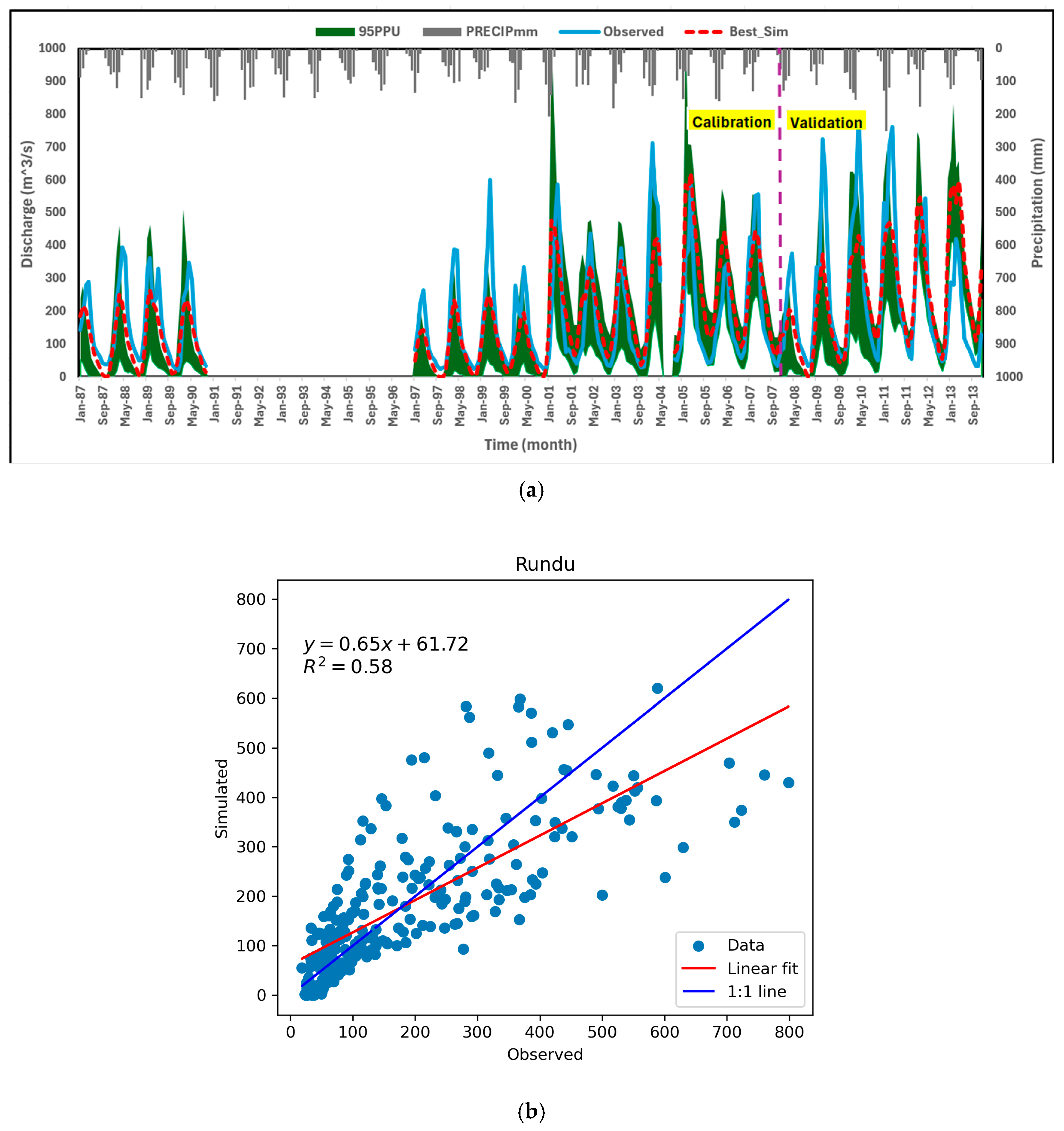
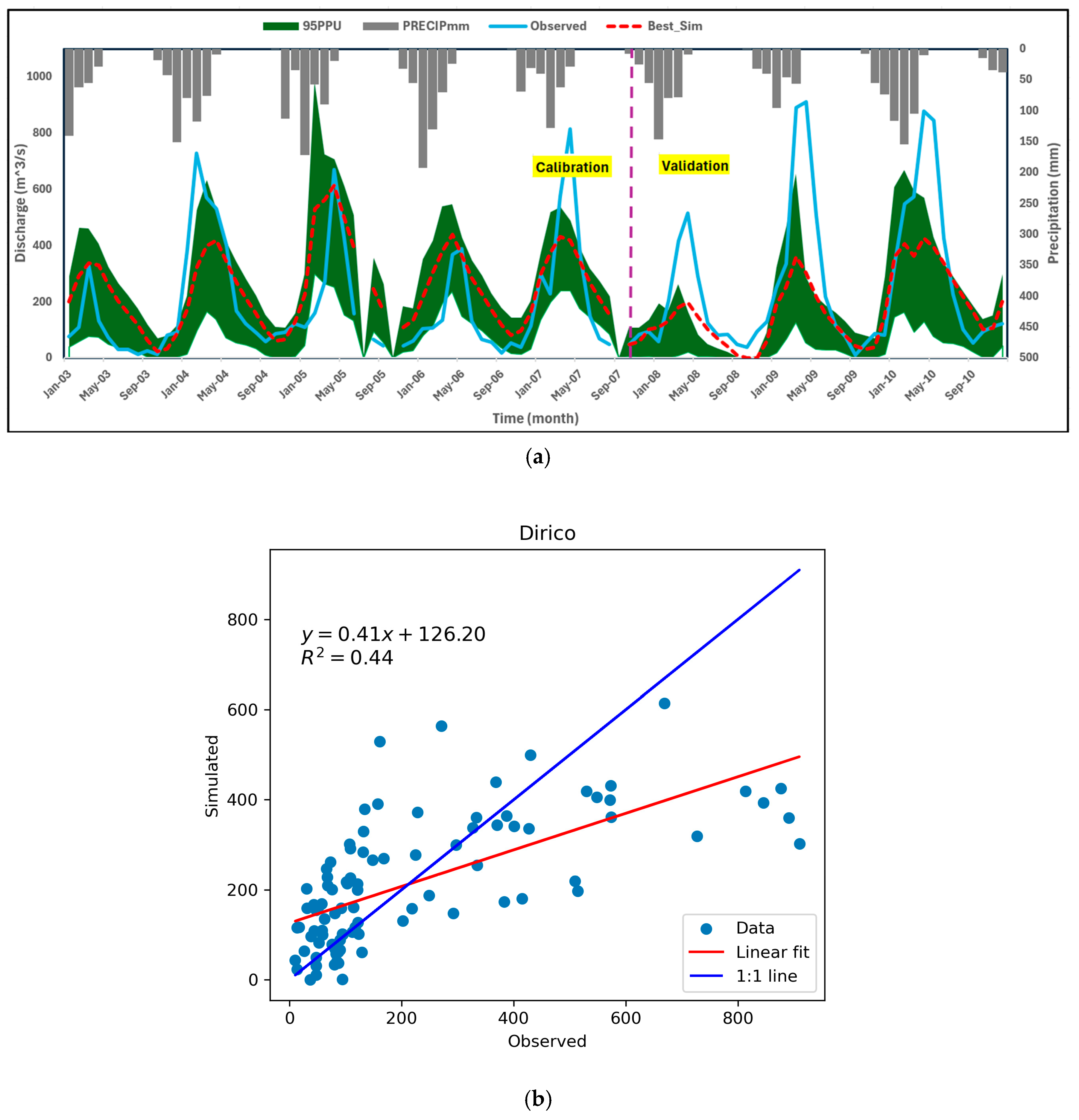

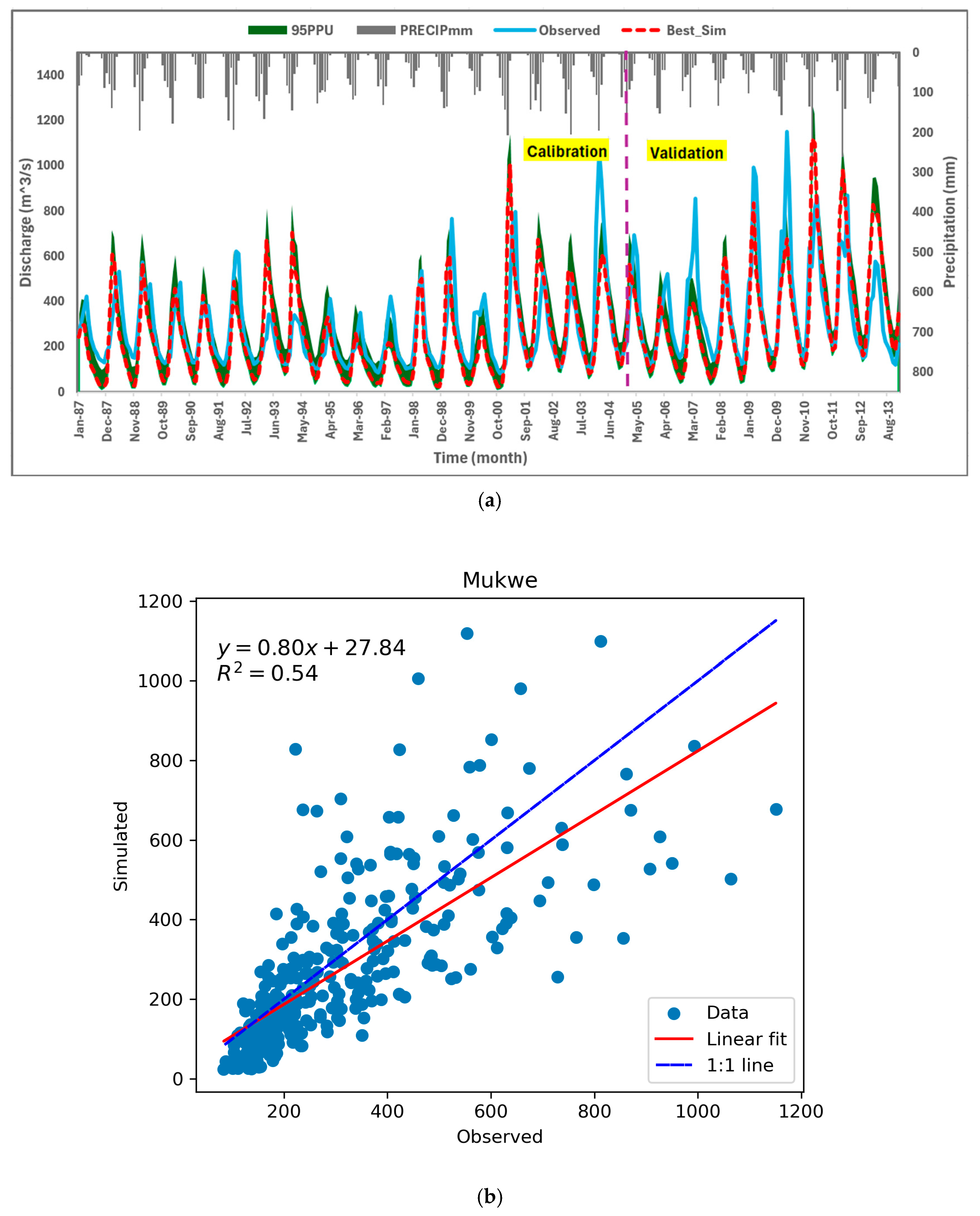
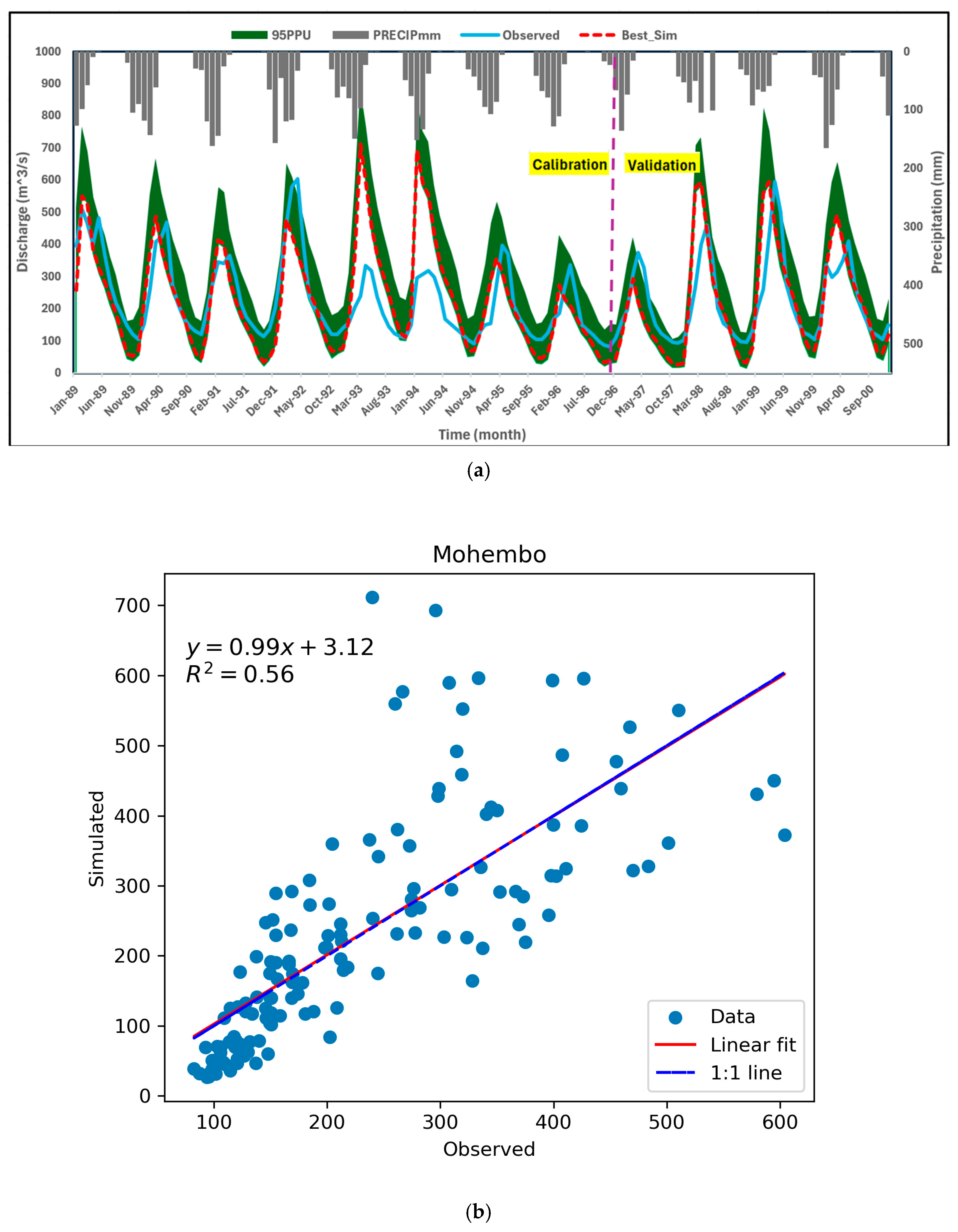
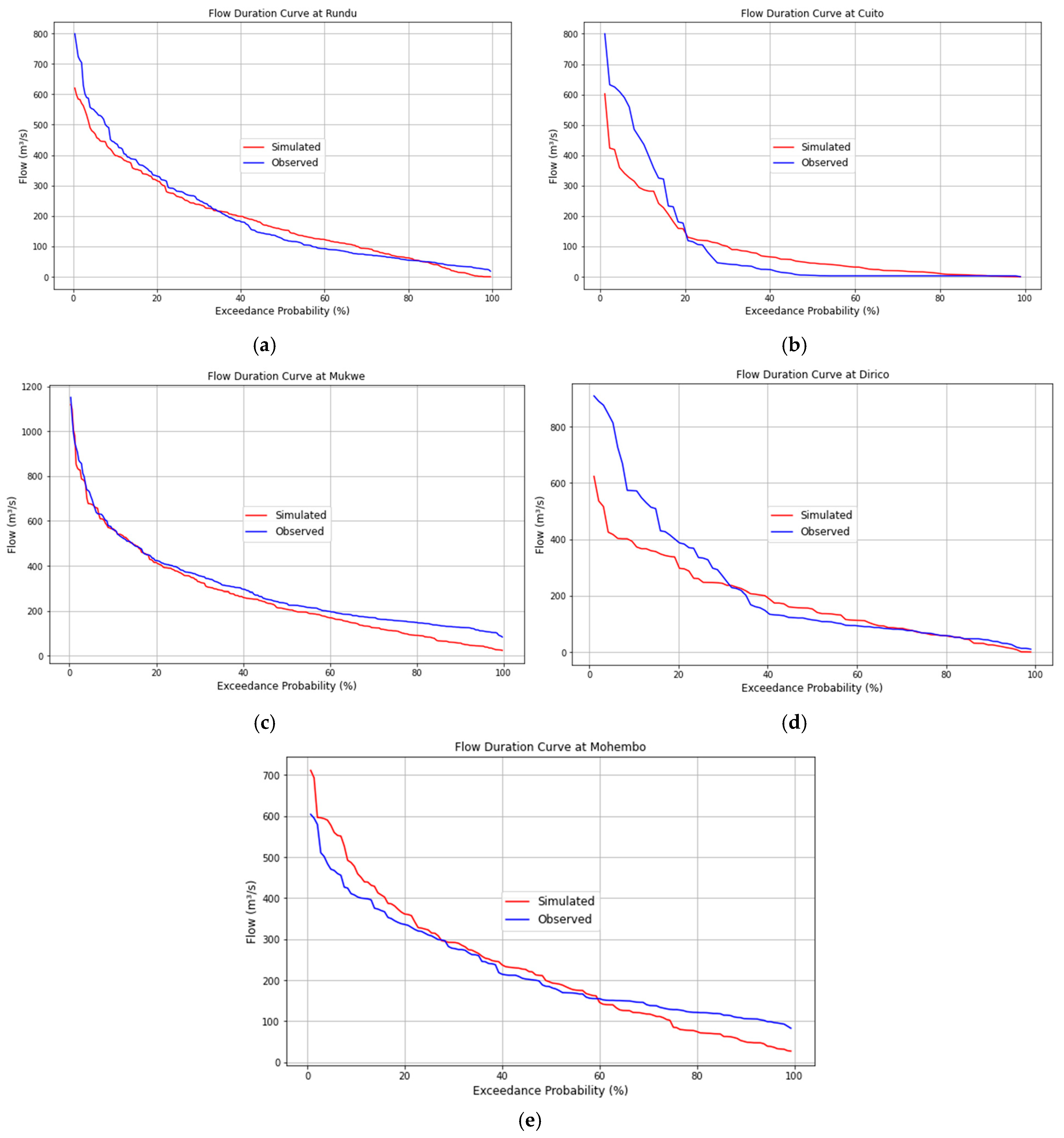
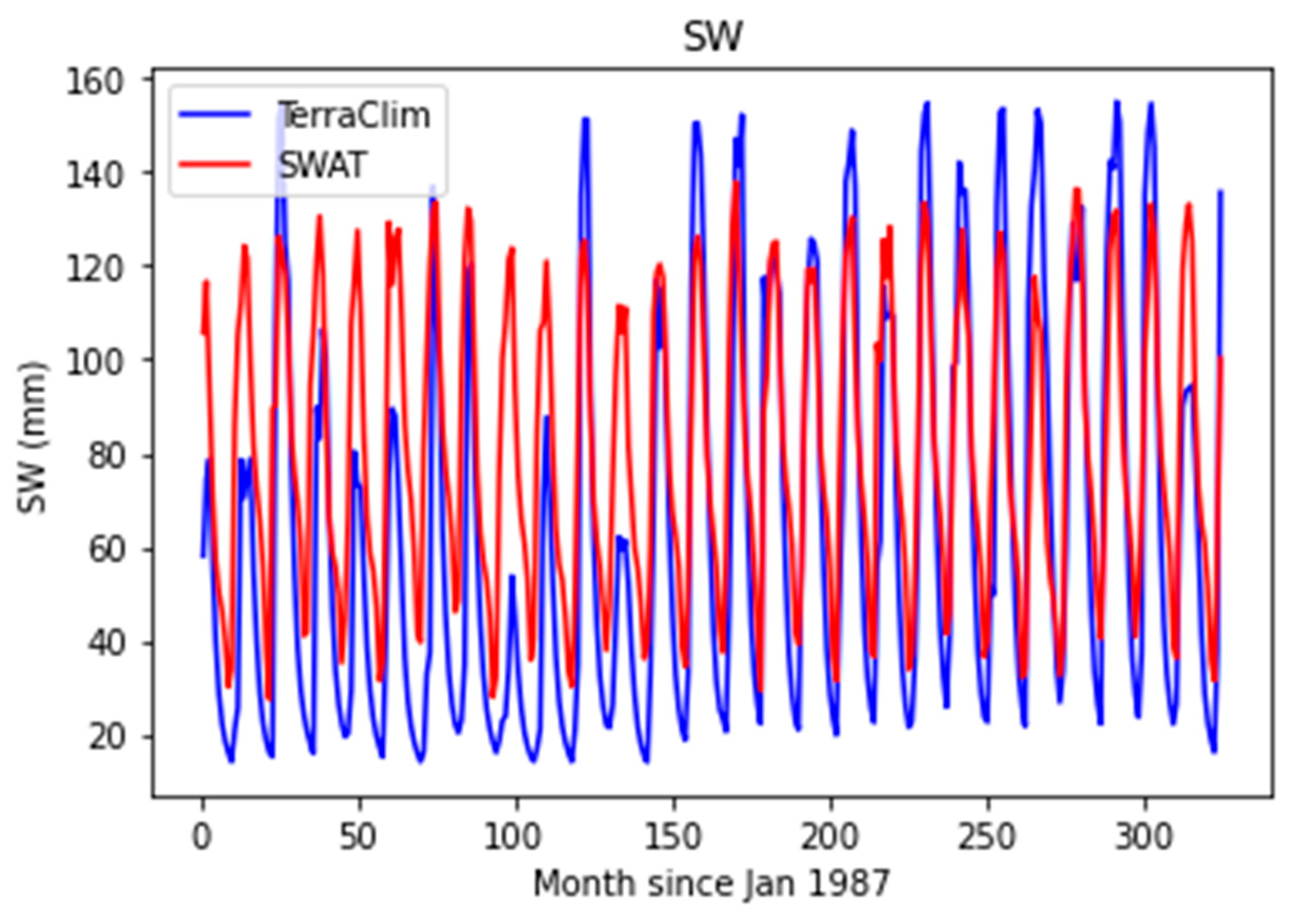

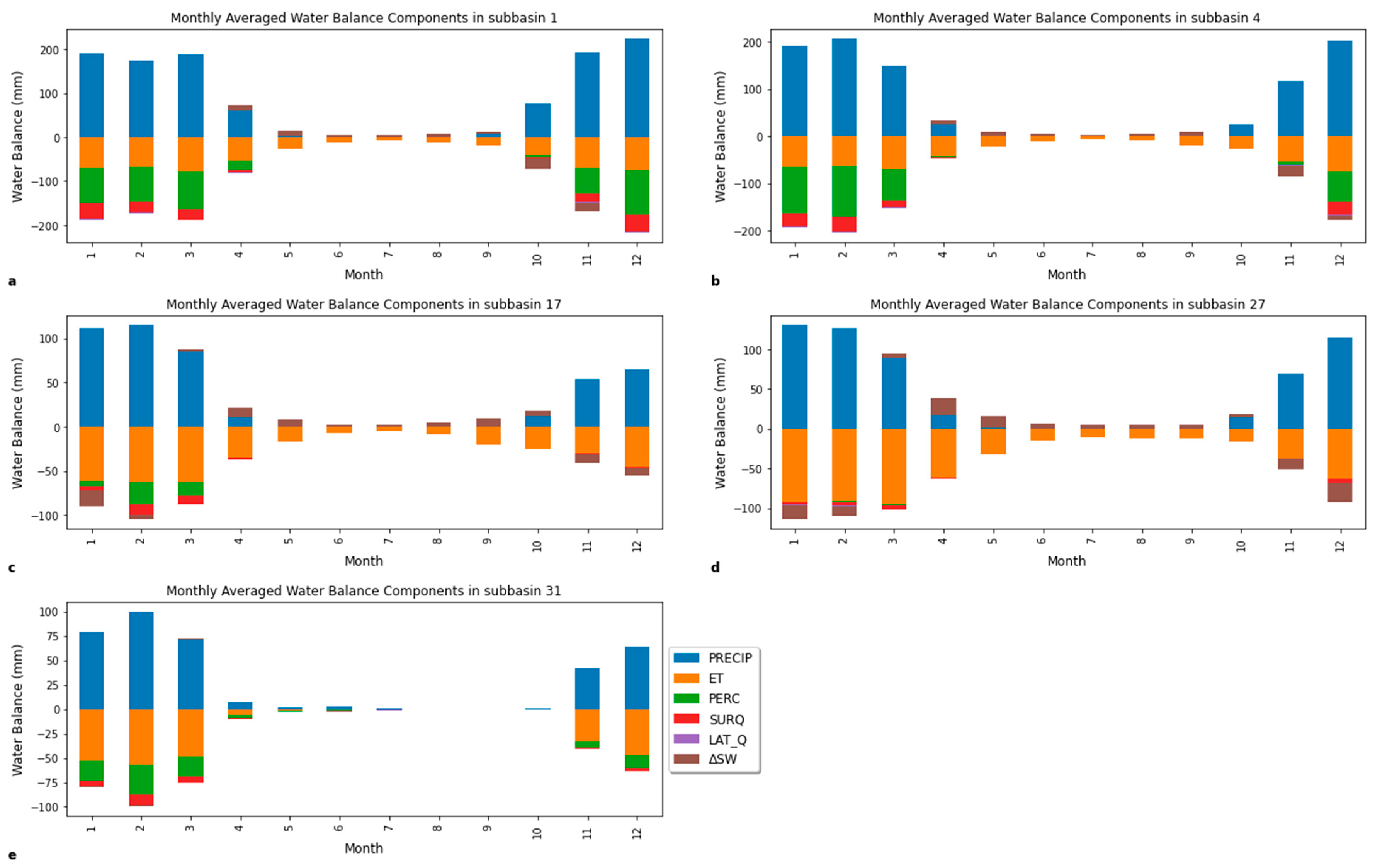
| Station | Min (Mon) | Max (Mon) | Mid | Mean | Std | %Missed | Data Period |
|---|---|---|---|---|---|---|---|
| Rundu | 18.43 (Dec-89) | 798.75 (Apr-10) | 124.24 | 131.67 | 168.43 | 24% | Jan-87 to Dec-13 |
| Dirico | 10.0 (Sep-09) | 910 (Apr-09) | 114 | 133.67 | 228.44 | 3% | Jan-03 to Dec-10 |
| Cuito | 0.3 (Jul-05) | 799.97 (Mar-07) | 4.48 | 15.27 | 185.97 | 0 | Jan-03 to Feb-10 |
| Mukwe | 83.43 (Nov-00) | 1151.12 (Apr-10) | 232.72 | 252.46 | 192.61 | 0 | Jan-87 to Dec-13 |
| Mohembo | 82.53 (Nov-96) | 603.96 (Apr-92) | 182.47 | 199.46 | 121.41 | 0 | Jan-89 to Dec-00 |
| Sensitivity Indices | Initial Range | ||||||||||||
|---|---|---|---|---|---|---|---|---|---|---|---|---|---|
| No | Parameter Name (Unit) | Rundu and Dirico | Cuito | Mukwe and Mohembo | Fitted Values | ||||||||
| t-Stat | p-Value | t-Stat | p-Value | t-Stat | p-Value | Rundu | Drico | Cuito | Mukwe | Mohembo | |||
| 1 | R__CN2.mgt | −3.573 | 0.000 | −0.791 | 0.429 | −0.131 | 0.896 | 35–98 | 58.053 | 77.798 | 74.095 | 36.108 | 59.411 |
| 2 | R__SOL_AWC(..).sol (mm/mm) | −1.603 | 0.109 | −0.371 | 0.711 | −0.639 | 0.524 | 0–1 | 0.24 | 0.26 | 0.2 | 0.06 | 0.06 |
| 3 | R__SOL_BD(1).sol (Mg/m3) | −5.760 | 0.000 | 1.392 | 0.164 | 0.002 | 0.998 | 0.9–2.5 | 1.36 | 1.28 | 0.98 | 1.65 | 1.37 |
| 4 | V__ESCO.hru | −1.073 | 0.284 | −1.045 | 0.297 | −0.010 | 0.992 | 0–1 | 0.243 | 0.418 | 0.185 | 0.021 | 0.01 |
| 5 | R__SOL_K(1).sol (mm/h) | −4.934 | 0.000 | 0.594 | 0.553 | −0.006 | 0.995 | 0–2000 | 15.44 | 25.39 | 125.26 | 2.28 | 2.75 |
| 6 | V__GWQMN.gw (mmH2O) | 1.194 | 0.233 | 1.559 | 0.119 | 0.009 | 0.993 | 0–5000 | 2741.5 | 359.68 | 4865.3 | 1.34 | 1.97 |
| 7 | V__GW_DELAY.gw (day) | 2.272 | 0.023 | 1.300 | 0.194 | 0.011 | 0.991 | 0–500 | 190.67 | 250.48 | 79.355 | 407.82 | 315.499 |
| 8 | R__SOL_Z(1).sol (mm) | 3.220 | 0.001 | −13.208 | 0.000 | 0.000 | 1.000 | 0–3500 | 338.54 | 347.46 | 377.55 | 7.25 | 38.64 |
| 9 | R__HRU_SLP.hru (m/m) | −0.167 | 0.867 | 0.161 | 0.872 | −0.026 | 0.979 | 0–1 | 0.025 | 0.012 | 0.043 | 0.02 | 0.01 |
| 10 | R__SLSUBBSN.hru (m) | 0.096 | 0.923 | −0.179 | 0.858 | −0.003 | 0.998 | 10–150 | 95.225 | 131.89 | 105.82 | 103.7 | 138.29 |
| 11 | R__OV_N.hru | 0.865 | 0.387 | 1.116 | 0.265 | −0.010 | 0.992 | 0.01–1 | 0.147 | 0.153 | 0.162 | 0.21 | 0.21 |
| 12 | V__REVAPMN.gw (mmH2O) | 1.585 | 0.114 | −0.431 | 0.668 | 0.005 | 0.996 | 0–1000 | 690.13 | 540.45 | 173.07 | 886.94 | 831.631 |
| 13 | V__ALPHA_BF.gw (day) | 0.049 | 0.961 | −1.207 | 0.233 | −0.006 | 0.995 | 0–1 | 0.856 | 0.642 | 0.092 | 0.989 | 0.989 |
| Period | Station Name | Efficiency Coefficients and Statistics | Time Coverage | ||||
|---|---|---|---|---|---|---|---|
| p Factor | r Factor | R2 | NSE | PBIAS | |||
| Calibration | Rundu | 0.66 | 1.22 | 0.61 | 0.59 | 4.4 | Jan. 1987–Dec. 2007 |
| Dirico | 0.75 | 1.25 | 0.49 | 0.41 | −28.7 | Jan. 2003–Dec. 2007 | |
| Cuito | 0.29 | 0.60 | 0.72 | 0.64 | −6.4 | Jan. 2003–Aug. 2007 | |
| Mukwe | 0.68 | 0.76 | 0.47 | 0.26 | 14.5 | Jan. 1987–Dec. 2004 | |
| Mohembo | 0.73 | 1.28 | 0.53 | 0.19 | −0.9 | Jan. 1989–Dec. 1996 | |
| Validation | Rundu | 0.56 | 0.98 | 0.51 | 0.51 | 0.1 | Jan. 2008–Dec. 2013 |
| Dirico | 0.47 | 0.76 | 0.69 | 0.42 | 36.1 | Jan. 2008–Dec. 2010 | |
| Cuito | 0.20 | 0.47 | 0.55 | 0.54 | 19.4 | Sep. 2007–Jul. 2010 | |
| Mukwe | 0.50 | 0.54 | 0.55 | 0.44 | 6.4 | Jan. 2005–Dec. 2013 | |
| Mohembo | 0.77 | 1.16 | 0.63 | 0.34 | 0.3 | Jan. 1997–Dec. 2000 | |
Disclaimer/Publisher’s Note: The statements, opinions and data contained in all publications are solely those of the individual author(s) and contributor(s) and not of MDPI and/or the editor(s). MDPI and/or the editor(s) disclaim responsibility for any injury to people or property resulting from any ideas, methods, instructions or products referred to in the content. |
© 2025 by the authors. Licensee MDPI, Basel, Switzerland. This article is an open access article distributed under the terms and conditions of the Creative Commons Attribution (CC BY) license (https://creativecommons.org/licenses/by/4.0/).
Share and Cite
Homa, M.G.; Mengistu Tsidu, G.; Lofton, E.N. Hydrological Modelling and Multisite Calibration of the Okavango River Basin: Addressing Catchment Heterogeneity and Climate Variability. Water 2025, 17, 1442. https://doi.org/10.3390/w17101442
Homa MG, Mengistu Tsidu G, Lofton EN. Hydrological Modelling and Multisite Calibration of the Okavango River Basin: Addressing Catchment Heterogeneity and Climate Variability. Water. 2025; 17(10):1442. https://doi.org/10.3390/w17101442
Chicago/Turabian StyleHoma, Milkessa Gebeyehu, Gizaw Mengistu Tsidu, and Esther Nelly Lofton. 2025. "Hydrological Modelling and Multisite Calibration of the Okavango River Basin: Addressing Catchment Heterogeneity and Climate Variability" Water 17, no. 10: 1442. https://doi.org/10.3390/w17101442
APA StyleHoma, M. G., Mengistu Tsidu, G., & Lofton, E. N. (2025). Hydrological Modelling and Multisite Calibration of the Okavango River Basin: Addressing Catchment Heterogeneity and Climate Variability. Water, 17(10), 1442. https://doi.org/10.3390/w17101442






